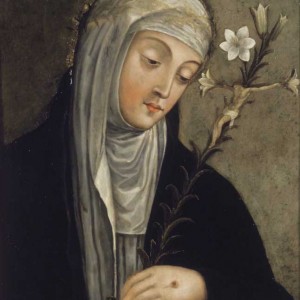Podcast: Play in new window | Download (Duration: 30:42 — 21.2MB) | Embed
Subscribe: Apple Podcasts | Spotify | Amazon Music | Android | Pandora | iHeartRadio | JioSaavn | Podchaser | Gaana | Podcast Index | Email | TuneIn | Deezer | Anghami | RSS | More

St. Catherine of Siena, Part 2 – The Doctors of the Church: The Charism of Wisdom with Dr. Matthew Bunson
- Born: March 17, 1347, Siena, Italy
- Died: April 29, 1380, Rome
- Nationality: Italian
Dr. Matthew Bunson and Kris McGregor discuss the life and teachings of St. Catherine of Siena. They highlight her maternal-like love and her profound spirituality, often likened to Mother Teresa’s. Pope Benedict XVI referred to her as a “spiritual mama” due to her embodiment of Christ’s love and willingness to suffer for others. They delve into St. Catherine’s spirituality, emphasizing her gift of tears, which Pope Benedict praised as a sign of profound sensitivity and tenderness.
They explore St. Catherine’s influence on various levels of society, from humble individuals to the Pope and entire republics. Despite her influence, St. Catherine remained grounded in prayer and humility, understanding the importance of detachment from sin and the virtues. Her writings, particularly “The Dialogue,” serve as practical guides to the spiritual life, emphasizing love, humility, and obedience.
St. Catherine’s pivotal role in urging Pope Gregory XI to return the papacy from Avignon to Rome, as well as her efforts to heal the Great Western Schism, are mentioned. Despite her failing health, St. Catherine continued to work tirelessly for the Church until her death, symbolizing her lifelong dedication and sacrifice.
Finally, they touch on the significance of Catherine’s relics and her enduring influence in both Rome and Siena. Dr. Bunson encourages listeners to explore St. Catherine’s writings and emulate her commitment to holiness and service to the Church.
For more on St. Catherine of Siena and her teachings visit her Discerning Hearts page.
Discerning Hearts Reflection Questions
- St. Catherine’s Spiritual Maternity: How does St. Catherine’s life exemplify a maternal-like love and Christ-like compassion for others?
- The Gift of Tears: Reflect on Pope Benedict XVI’s description of St. Catherine’s “gift of tears” as a sign of profound sensitivity and tenderness. How can we cultivate a similar depth of emotion in our spiritual lives?
- Practical Spirituality: In what ways did St. Catherine balance her intense spiritual life with practical engagement in societal and political issues? How can we emulate this balance in our own lives?
- The Dialogue as a Practical Guide: Explore the practical insights offered in St. Catherine’s “The Dialogue.” How can her teachings on detachment from sin, virtues, and love be applied in our daily lives?
- Influence on Church History: Reflect on St. Catherine’s pivotal role in urging Pope Gregory XI to return the papacy to Rome. How can we, like Catherine, work to heal divisions within the Church and promote unity?
- Endurance and Sacrifice: St. Catherine continued to serve the Church tirelessly despite her failing health. How does her example inspire us to persevere in our own challenges and commitments?
- Legacy and Influence: Consider the enduring influence of St. Catherine’s relics and her impact on both Rome and Siena. How can we honor her legacy by deepening our devotion to Christ and serving others selflessly?

From Vatican.va, an excerpt from the teachings of Pope Benedict XVI
From the General Audience on St. Catherine of Siena
“A true and authentic spiritual family was built up around such a strong and genuine personality; people fascinated by the moral authority of this young woman with a most exalted lifestyle were at times also impressed by the mystical phenomena they witnessed, such as her frequent ecstasies. Many put themselves at Catherine’s service and above all considered it a privilege to receive spiritual guidance from her. They called her “mother” because, as her spiritual children, they drew spiritual nourishment from her. Today too the Church receives great benefit from the exercise of spiritual motherhood by so many women, lay and consecrated, who nourish souls with thoughts of God, who strengthen the people’s faith and direct Christian life towards ever loftier peaks. “Son, I say to you and call you”, Catherine wrote to one of her spiritual sons, Giovanni Sabbatini, a Carthusian, “inasmuch as I give birth to you in continuous prayers and desire in the presence of God, just as a mother gives birth to a son” (Epistolario, Lettera n. 141: To Fr Giovanni de’ Sabbatini). She would usually address the Dominican Fr Bartolomeo de Dominici with these words: “Most beloved and very dear brother and son in Christ sweet Jesus”.
Another trait of Catherine’s spirituality is linked to the gift of tears. They express an exquisite, profound sensitivity, a capacity for being moved and for tenderness. Many Saints have had the gift of tears, renewing the emotion of Jesus himself who did not hold back or hide his tears at the tomb of his friend Lazarus and at the grief of Mary and Martha or at the sight of Jerusalem during his last days on this earth. According to Catherine, the tears of Saints are mingled with the blood of Christ, of which she spoke in vibrant tones and with symbolic images that were very effective: “Remember Christ crucified, God and man….. Make your aim the Crucified Christ, hide in the wounds of the Crucified Christ and drown in the blood of the Crucified Christ” (Epistolario, Lettera n. 21: Ad uno il cui nome si tace [to one who remains anonymous]). Here we can understand why, despite her awareness of the human shortcomings of priests, Catherine always felt very great reverence for them: through the sacraments and the word they dispense the saving power of Christ’s Blood. The Sienese Saint always invited the sacred ministers, including the Pope whom she called “sweet Christ on earth”, to be faithful to their responsibilities, motivated always and only by her profound and constant love of the Church. She said before she died: “in leaving my body, truly I have consumed and given my life in the Church and for the Holy Church, which is for me a most unique grace” (Raimondo da Capua, S. Caterina da Siena, Legenda maior, n. 363). Hence we learn from St Catherine the most sublime science: to know and love Jesus Christ and his Church. In the Dialogue of Divine Providence, she describes Christ, with an unusual image, as a bridge flung between Heaven and earth. This bridge consists of three great stairways constituted by the feet, the side and the mouth of Jesus. Rising by these stairways the soul passes through the three stages of every path to sanctification: detachment from sin, the practice of the virtues and of love, sweet and loving union with God.
Dear brothers and sisters, let us learn from St Catherine to love Christ and the Church with courage, intensely and sincerely. Therefore let us make our own St Catherine’s words that we read in the Dialogue of Divine Providence at the end of the chapter that speaks of Christ as a bridge: “out of mercy you have washed us in his Blood, out of mercy you have wished to converse with creatures. O crazed with love! It did not suffice for you to take flesh, but you also wished to die!… O mercy! My heart drowns in thinking of you: for no matter where I turn to think, I find only mercy” (chapter 30, pp. 79-80).”
For more visit Vatican.va
For more from Dr. Matthew Bunson, check out his Discerning Hearts page.
Dr. Matthew E. Bunson is a Register senior editor and a senior contributor to EWTN News. For the past 20 years, he has been active in the area of Catholic social communications and education, including writing, editing, and teaching on a variety of topics related to Church history, the papacy, the saints and Catholic culture. He is faculty chair at Catholic Distance University, a senior fellow of the St. Paul Center for Biblical Theology, and the author or co-author of over 50 books including The Encyclopedia of Catholic History, The Pope Encyclopedia, We Have a Pope! Benedict XVI, The Saints Encyclopedia and best-selling biographies of St. Damien of Molokai and St. Kateri Tekakwitha.


